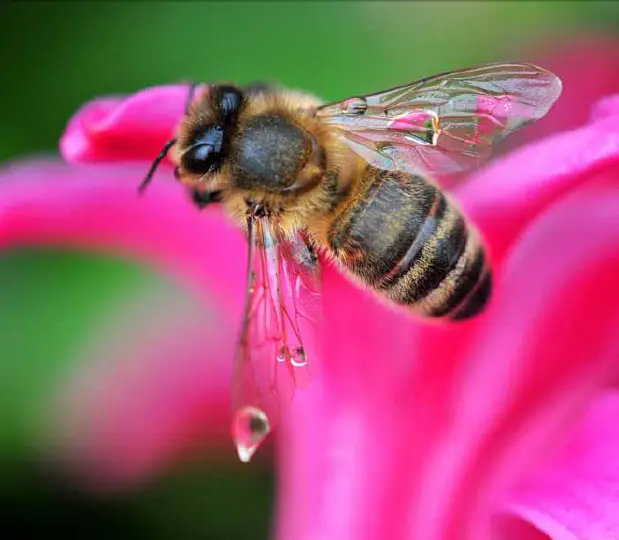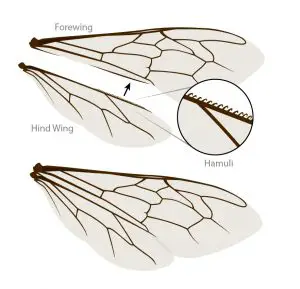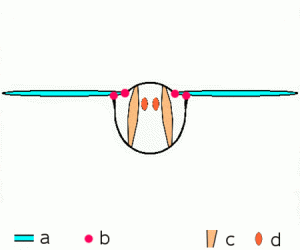When I was young, I remember going on walks with my family in the summer. There was a field near our house that we’d always walk through. In the field there were an assortment wild flowers. Little splashes of color in the long grass.
I’d always see bees on those flowers, their little bee heads poking inside like a kid reaching for the last cookie in the cookie pot. Then, without warning, they’d fly off, and due to my astigmatism, disappear into thin air. They were always so busy; but where were they coming from? And where were they rushing back to?
Below are some commonly asked questions that I also had about the flight behaviour of those busy little bees.
How far can bees fly?
Bees can fly roughly 2 miles in any direction from their hive. However, the shorter the flight, the better, as bees will avoid wasting energy traveling long distances whenever they can.
Bees fly from the hive in order to forage, and it’s generally accepted that the foraging area for a Beehive is around two miles. However, bees have been known to fly far beyond this in search of food, and research has shown that as long as there’s a food source within four miles of a hive, the population (measured in weight) will increase.
So, while bees prefer to fly only two miles at most, it seems the true limit lies around the four-mile mark. Beyond that, it seems the energy used to fly and retrieve resources outweighs the return. It has also been noted that flying long distances will wear out a bee’s wings, severely shortening its lifespan, and putting a strain on the colony as it struggles to replace them.
What temperature can bees fly?
Most bee species will only fly when temperatures are between 13°C and 37°C.
The minimum temperature most bees will tolerate when flying is 13°C. For a hive to fully commit to foraging for food, the temperature must be around 19°C.
While the above statistics are generally agreed upon, there are always exceptions, including some variations for temperature tolerance between different species of bee.
For example, many beekeepers note that European Dark Bees are willing to fly in much colder weather than the other species they keep.
Can bees fly in the rain?
Bees can fly in light rain but will avoid it if possible. Rain weighs down bees, making their wings heavy, causing them to waste energy attempting to stay in the air.
Heavier rain not only weighs bees down, but due to large raindrops, can damage their wings.

Bees manage to avoid flying in the rain by using their uncanny ability to predict the weather.
Numerous studies have shown that Bees are very capable at predicting the weather, sometimes even more so than us humans. Not only can they detect when a storm is coming, they also seem to be able to gauge the severity as well.
A paper entitled “The Effects of Meteorological Factors on Defensive Behaviour of Honey Bees”, published in the International Journal of Biometeorology, showed that honey bees change their behaviour when a large storm was on its way to the area. The researchers found that honey bees displayed increased defensive behaviour in reaction to environmental influences such as weather conditions, humidity, temperature, UV Rays, air pressure, and wind speed.
Bees have been seen to stockpile supplies in the days leading to a storm, working harder, longer days. They seem to expect the delay in foraging, and therefore the food shortage, the storm may cause.
How far do bees fly in a day?
A honey bee will continue to forage for food for as long as there is daylight, the weather is suitable, and the hive conditions warrant it.
A honey bee might cease its foraging when the “wait time” to deposit its collected resources takes too long. This “wait time” for an individual forager can increase due to the foraging bee bringing back sub-par or unfamiliar resources, the bees usually used to collect the resources are needed elsewhere in the hive, or there are too many bees foraging at once.
How high can bees fly?
Some Bees can fly extraordinarily high, equivalent to the peak of mount Everest. However, they will usually only fly just higher than the tallest obstacle in their flight path.
The limiting factor for the height bees can fly does not seem to be the altitude, but rather the temperature. Bees cannot fly well when outside temperatures drop below 13°C, as they need to have a high enough internal temperature for their chemical processes to function fast enough to support the energy used flying.
Honey bees will fly straight out of their hive towards their foraging location. They will avoid objects by flying over them, rather than finding a route around them. Unexpected obstacles in a bee’s flight path can surprise the bee, and if it’s a living organism, can result in a sting.
How fast can bees fly?
Most honey bees have a normal flying speed of 15mph to 20mph. Laden with pollen, nectar, or when wet, this will drop to around 12mph.
The “bible” of Beekeeping The Hive and the Honey-Bee, goes into this in more detail, and explores the foraging behaviours of bees, as well as the differences in flying behaviour between different types of bees within the hive.
When do bees usually fly?
Bees will fly throughout the day, so long as environmental conditions such as weather, temperature, and hazards permit.
Most species of bees are not early-birds, nor are they night-owls, with most flight times being between 9am to 5pm. However, this does vary from species to species. The location of the hive will also influence when bees are out and about, along with other local factors such as the weather, and if there are any potential hazards near the hive.
Do bees fly at night?
Yes, certain species of bees can fly at night, with most of these species being found in tropical climates.
Some flowers found in the rainforest are open at night, which allows night-flying bees to forage for resources when competition from other pollen collecting insects is low.

Bees capable of flying during night time have some marked differences to their day-flying relatives, including specialised eyes designed to function in darker environments. While many tropical species of bees can fly at night, only the Indian Carpenter Bee can fly in total darkness. Other species require low levels of moonlight to function.
How to honey bees fly?
Honey bees use four flexible wings to make short, fast, sweeping motions which creates enough lift to let them fly.
While honey bees have four wings, one set of small inner wings, and a set of larger outer wings, small teeth-like structures called hamuli hold the larger and smaller wings together allowing the bee to utilise all four wings as though they had only two.

For a long time, scientists couldn’t figure out how the relatively small wings of honey bees could handle the weight of the bees. This was until their initial assumption that bee’s wings were rigid was quashed thanks to a slow motion video of a honey bee flying.
As you can see in the above video, a bee’s wings are actually very flexible, with the bee utilising this flexibility to create thrust that would not possible with rigid wings.
Scientists have noted that other insects have a slower, longer wing beat, meaning that they can achieve higher lift with more efficiency. Many scientists believe bees use a seemingly inefficient flying technique to allow them to handle an increased load, such as when they are laden with pollen.
Can bees fly backwards?
Yes, bees possess a muscle called the asynchronous flight muscle, which allows them to fly backwards and hover.

The diagram above illustrates how the asynchronous flight muscles function. This internal trait sacrifices control and flexibility for higher force and increased efficiency.
Certain aspects of the methods bees, and other insects, fly are being used in the development of tiny flying robots, such as the Harvard-engineered RoboBee.
For more information on Bees and their behavours, take a look at our Big Bee List. (coming soon!)


![3 Big Mistakes Beginner Beekeepers Make [And How To Avoid Them!]](https://beekeepingabc.com/wp-content/uploads/2020/11/3-mistakes-beginner-beekeepers-make-90x75.jpg)

![Move over ducks, Queen Bees quack too! [Here’s Why]](https://beekeepingabc.com/wp-content/uploads/2020/06/queen-bee-90x75.png)
![The Flow Hive 2 Review [ Vs. The Classic Flow Hive]](https://beekeepingabc.com/wp-content/uploads/2020/02/Flow-Hive-2-90x75.jpg)
![How Bees Fly [10 Facts About How, When, and Why]](https://beekeepingabc.com/wp-content/uploads/2019/12/A-Bee-Flying-90x75.jpg)